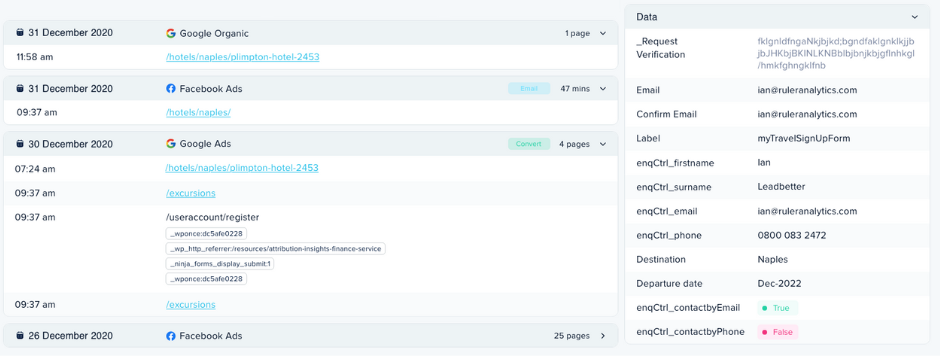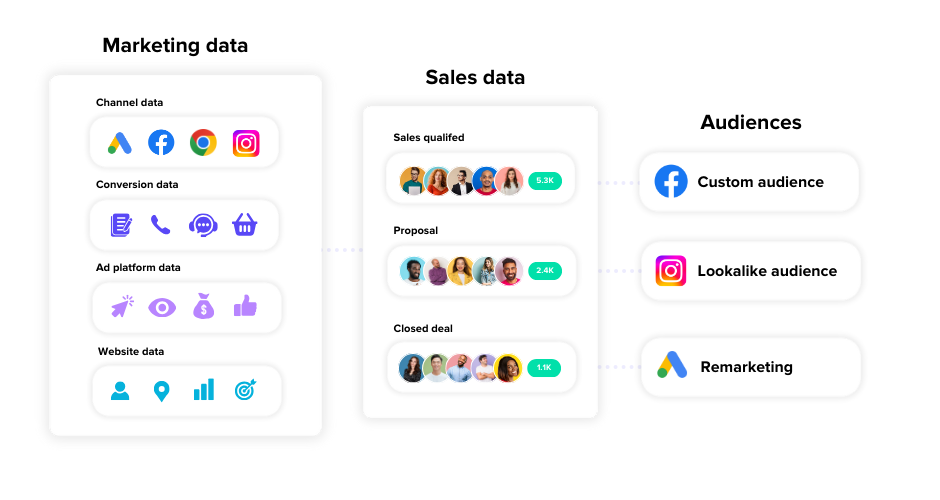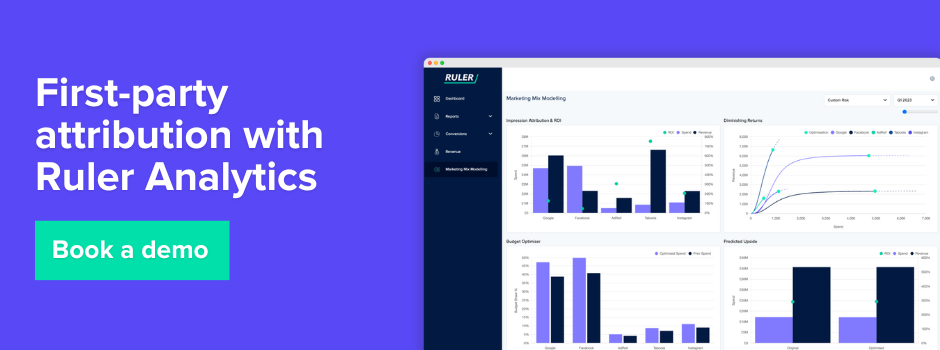Discover how first-party data activation improves campaign efficiency and helps ad platforms allocate budget toward what actually drives revenue.
Advertisers are feeling the pressure from all sides.
Apple’s iOS changes have severely limited cross-app tracking, and third-party cookies are nearly obsolete.
And regulators keep tightening the rules on what you can and can’t do with customer data.
It’s not just one change, it’s all of them hitting at once.
Targeting has become harder, and the old playbooks don’t work anymore.
But there’s still a way through. While third-party data gets phased out and platform signals become unreliable, first-party data – stuff you collect directly from your customers, keeps its value.
It’s unaffected by browser changes, app restrictions, or shifting legal frameworks. And done right, it helps you target based on real customer understanding, not just what someone clicked on last week.
This post breaks down why first-party data matters more now, and how you can actually activate it to make your ad campaigns sharper and more resilient.
We discuss:
💡 Pro Tip
Ruler’s first-party tracking enables the capture of UTMs, click IDs, page views, and referrers across multi-touch journeys. These data points are tied to user conversions – such as calls, chats, or form submissions – and integrated into your CRM or ecommerce platform. This allows marketers to attribute key offline interactions, like meetings and demos, to the original marketing source.
Once a lead hits a defined stage in your CRM or sales tracking tool, Ruler pushes that data back to your ad platforms using the original identifiers. This feedback loop gives marketers the insights they need to understand what channels and campaigns drive results, enabling stronger attribution and smarter bidding strategies.
Book a demo to setup first-party data activation
First-party data activation means using the customer data you’ve collected – through your website, app, CRM, or offline touchpoints – to power advertising, measurement, and personalisation.
It’s not just about storing data. It’s about making it useful.
The data is yours, you’re not relying on third-party cookies or borrowed signals from platforms.
Related: What does the future hold for third-party cookies?
That gives you more control over how you reach people, how you track performance, and how you grow value from your audience over time.
You can build segments based on actual behaviour, not inferred intent, and target with context that platforms can’t see.
More importantly, it’s durable. You don’t lose it when Chrome changes its policies or when Apple shuts down another tracking method.
Owning your data gives you a long-term edge. You’re not at the mercy of someone else’s rules, and that makes a difference.
When Apple rolled out iOS 14.5 in April 2021, it changed mobile advertising overnight.
The update forced apps to show a popup asking users if they wanted to be tracked across other apps and websites.
On a global scale, 50% of users of apps now opt-in to tracking, marking a 10% increase since ATT’s rollout.
That single change stripped ad platforms of visibility into the majority of mobile user behaviour.
Meta was hit especially hard, losing access to the kind of cross-app data that powered its targeting and optimisation systems. But Google felt it too.
Remarketing audiences shrank. Lookalike models weakened because the seed audiences became smaller and less representative. Platforms were flying blind.
B2B marketers faced an extra layer of difficulty. Their sales cycles are longer, and conversions often happen outside of the platform where the ad ran.
Someone might click an ad from their phone, then convert a few weeks later through a sales call or desktop visit. That journey became invisible.
Attribution broke down. Campaigns started getting under-reported, budgets got misallocated, and platforms struggled to optimise because they couldn’t see what was actually working.
Apple’s iOS changes shook up mobile app ads, but that was only the beginning.
The deprecation of third-party cookies is reshaping the entire web advertising ecosystem.
Since the late ’90s, third-party cookies have been the infrastructure holding digital advertising together.
They’ve enabled cross-site tracking, audience building, frequency capping, and attribution modelling.
If someone visits your site and later sees your ad on a news site, that link is made through a third-party cookie.
If you build a lookalike audience based on site visitors, cookies are what power that match.
That system is falling apart. Safari and Firefox have already blocked third-party cookies completely.
Google has started letting users opt out, and plans to remove them entirely from Chrome. Each of these steps breaks more of the web’s ad plumbing.
This affects more than targeting. Attribution across multiple websites becomes close to impossible.
You can’t see how a user moved from an ad to a purchase if you can’t connect the steps.
Frequency capping across domains stops working too, so users might end up seeing the same ad over and over again, which burns budget and annoys your audience.
The tools advertisers relied on for decades are becoming less reliable. What replaces them needs to be owned, privacy-safe, and built for a world where platforms give you less, not more.
Some of the most important conversions don’t happen online.
They happen in sales calls, in stores, or over email, completely invisible to the ad platforms that drove the initial interest.
Related: Your guide to Google Ads offline conversions 2025
Take a typical B2B flow. Someone clicks a Facebook ad, books a demo, and then disappears into the sales process. Six weeks later, they sign a deal.
But, Meta doesn’t see that. It counts the demo request as the conversion and uses that to optimise. The platform assumes every demo is equally valuable.
It can’t tell the difference between a window shopper and a qualified lead with budget and urgency.
So what happens? Your campaigns get better and better at finding people who request demos, not people who actually buy.
You start over-indexing on early-stage leads, people who’ll download a whitepaper or start a trial, but never convert.
This isn’t just a B2B issue. Retail brands with strong in-store sales face the same blind spot.
A customer might see an ad, browse online, then walk into a shop and buy. The ad platform doesn’t see the sale. E-commerce businesses with phone support or live chat-assisted purchases run into similar gaps.
Over time, this incomplete feedback loop skews everything. Platforms optimise toward the wrong signals.
You might see a healthy-looking CPA based on form fills, but your true cost of acquiring a paying customer, especially when you factor in sales effort, tells a different story.
The combined effects of iOS privacy changes, third-party cookie loss, and offline blind spots have led to what many call signal loss.
Ad platforms now get less reliable data about who’s clicking, converting, or buying. As a result, targeting gets fuzzier.
Costs go up. Performance goes down.
But the answer isn’t to ditch digital advertising. It’s to feed platforms better data – what you already own.
That’s what first-party data activation is about. It’s using what you know about your customers to make up for what the platforms no longer see.
This starts with a first-party data platform. It’s what ties everything together.
Related: 4 steps to create a first-party data strategy
While ad platforms can track conversions inside their own walls, they ignore anything that happens offline or through other channels.
If someone fills in a form, takes a demo call, and buys six weeks later, most of that journey is invisible to the ad platform.
Same goes for all the touchpoints across your website or other marketing channels that helped influence the sale.
With first-party tracking tags, you can capture much more – page views, UTM parameters, source data, session info, and onsite behaviour.
A data platform collects all this, matches it to a user, and sends key identifiers – like click IDs – back to your ad platforms. This helps rebuild the missing signal.
Take Ruler, for example.
It uses custom tracking to collect UTM tags, click IDs, cookies, and page interactions, and stitches it all together in one view.
When someone becomes a lead or converts, their online journey – no matter how long it was or how many channels they used – is passed to your CRM. Now you’ve got the whole picture, from first visit to final sale or close.

So if a lead closes over the phone or via sales outreach, you can still match that conversion back to the original ad.
Platforms like Google Ads and Microsoft Ads can receive that data – gclid, fclid, and more – so they can learn from it and optimise toward what actually drives revenue, not just form fills or sales.
Beyond attribution, this data lets you segment audiences more precisely.

For example, you can:
A lot of this can be automated. API connections keep your platforms updated in real time, so your campaigns stay aligned with what your customers are doing, not just what the platform thinks they’re doing.
The way we target and measure advertising is changing fast, and not in ways that favour marketers.
iOS privacy updates, third-party cookie deprecation, and the gap between online clicks and offline conversions have all contributed to a serious loss of visibility.
Ad platforms are working with less data, which means less precision, more wasted budget, and fewer high-value customers.
But this isn’t the end of effective advertising. It’s just a shift in where the advantage lies.
First-party data activation gives you the tools to regain control. By collecting your own data, connecting it across touchpoints, and feeding it back into the platforms, you can rebuild the signals that matter.
You can guide algorithms with real outcomes, not proxy conversions. And you can build targeting strategies based on what’s actually working, not what the platforms think is working.
If you’re ready to see how first-party data activation can improve your ad targeting, attribution, and ROI, book a demo and we’ll show you how it works in practice.
